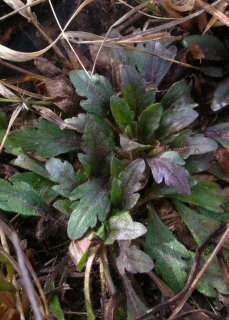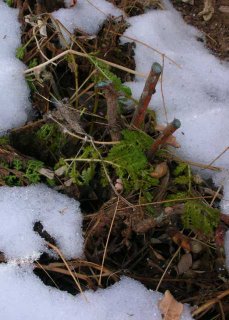 What’s blooming in the area: Plum, bradford pear, purple-leaf sand cherry, fence rows of pink and white flowered trees; pastel tulips, tansy and purple mustard, dandelion, stickseed whitebristle; apple buds; potted roses at one local hardware where a man bought some for next week’s opening at the ballfield because no bedding plants were available yet.
What’s blooming in the area: Plum, bradford pear, purple-leaf sand cherry, fence rows of pink and white flowered trees; pastel tulips, tansy and purple mustard, dandelion, stickseed whitebristle; apple buds; potted roses at one local hardware where a man bought some for next week’s opening at the ballfield because no bedding plants were available yet.What’s blooming in my yard: Sand, sweet and sour cherries, peach, forsythia, moss phlox, yellow alyssum, hyacinth, grape hyacinth, pushkinia, first daffodil open but few left in area; buds on Bath pink, coral bells, Siberian pea shrub; peach more fragrant than hyacinths all week.
What’s blooming inside: Aptenia, kalanchoë, zonal geranium; new honeysuckle bud.
What’s reviving in the area: Heath aster, loco up; leaves on silver lace vines; Bermuda grass spreading. One man was pruning his fruit trees yesterday, another was tilling his orchard.
What’s reviving in my yard: Leaves opening on snowball, peach, cherries, weiglia.
Animal sightings: Blue tinged bird apparently is the one nesting in my porch soffit; a neighbor says he replaced the hanging porch lamp where birds nested last year with a basket; nest visible in tree down the road.
Weather: New moon; last Sunday damp air and stillness suggested the calm before a storm; winds and rain passed through later in the week, left the ground wet; frost on leaves yesterday morning. One hardware covered all its plant racks with tarps and lined the garden area fence with garbage bags to protect plants Friday night; it also stopped shipments of bedding plants.
Weekly update: Plant catalogs promote heirloom varieties to tempt the unwary with visions of ancestral estates. I succumbed when I bought a dozen Distinction hyacinths in 1996. Ten years and several floral transformations later, I wonder what’s been blooming.
Jo Ann Gardner uses 1950 as a cut-off date for The Heirloom Garden, just before nurserymen began releasing plants for the new Levittown style suburbs with their smaller yards. This was certainly a milestone for hyacinths which demand grand massed formal beds that can be ignored, covered or reused during the summer. No one where I grew up had such space or labor, not even the city park. At best, maybe three people in the older part of town had double lots with herbaceous borders.
Although I’m sure people had short palings hidden near a door, as I’m sure they do here, the only ones I remember were grocery store pots ready to force into winter bloom. The newer houses, with their 4' x 8' construction, were too small to disburse the strong fragrance.
Hyacinths have been in decline ever since breeders began discovering successive waves of newer middle classes. Charles Darwin reported Amsterdam had nearly 2,000 varieties in 1768, but Haarlem knew only 700 in 1864. Last year, McClure and Zimmerman offered 21 cultivars and John Scheepers 14, with 26 unique varieties between them. Mass market catalogs typically offer one pink, one blue, one white, and maybe a yellow or purple.
When I bought those first heritage bulbs I was tired of seeds that were developed for greenhouse growers, and hoped longevity in the market signified durability in the garden. Distinction was introduced in 1880.
Ten of the dozen bulbs sprouted in 1997, and continued to arrive every spring, albeit with increasingly sparser flowers and shorter stems. Most didn’t survive the drought of 2002: today, two clumps remain with narrow grape-colored stalks and spaced florets that resemble their scilla cousins more than the commercial Hyacinthus orientalis.
When I needed replacements, Distinction was no longer available. I settled for ten Queen of the Violets, an 1883 sport of King of the Blues which itself had been introduced in 1863. Two plants with lighter, bluer heads showed in spring. One is blooming now, proving a pedigree is no guarantee a plant will thrive in the rio arriba.
Last year the Queen went out of circulation, so I looked for a color more like Distinction when I ordered replacements. It no longer mattered that Woodstock was recently introduced. I no longer cared to hear it was a mutant form of Jan Boss, developed in 1910 and distributed in 1927. I’m content they all emerged, and are either blooming or budded.
It will be another year before I know if Woodstock is as hardy as Distinction, for it seems that when I was searching for a more Edenic past, I put my bulbs in the least hospitable place in my yard, under a ramp where the shade is so dry not even weeds volunteer. Inadvertently I evoked their primeval home, now the Taurus mountains, where hot dry summers alternate with wet winters. Those that survived are the ones that had preserved the legacy of their forefathers for themselves and their progeny.
Notes:
Darwin, Charles. Variation in Animals and Plants under Domestication, 1868; cites Des Jacinthes, de leur Anatomie, Reproduction, et Culture, 1768, and Mr. Paul, Gardener's Chronicle, 1864.
Darwin, Charles. Variation in Animals and Plants under Domestication, 1868; cites Des Jacinthes, de leur Anatomie, Reproduction, et Culture, 1768, and Mr. Paul, Gardener's Chronicle, 1864.
Gardner, Jo Ann. The Heirloom Garden, 1992.
John Sheepers, Inc. 2006 catalog.
McClure & Zimmerman. 2006 catalog.
Tijssen Historic Bulbs. Hyacinth release dates at http://home.wanadoo.nl/janpiet.tyssen/index/hyacinthus.htm.
Photograph: Ten-year old Distinction hyacinths, with first year Woodstock in middle ground and moss phlox and other plants in back, 8 April 2007.














